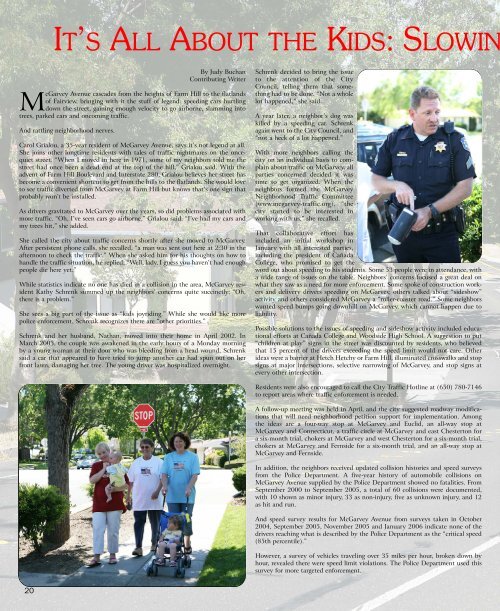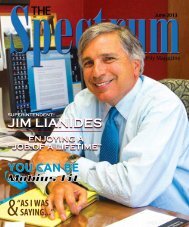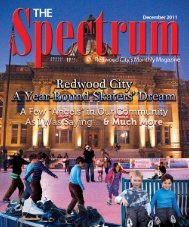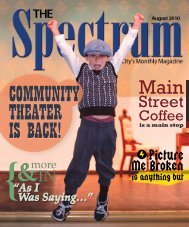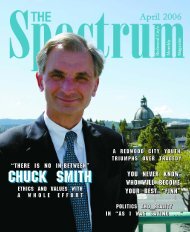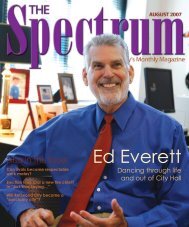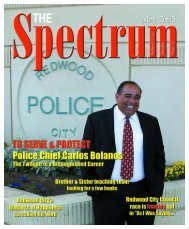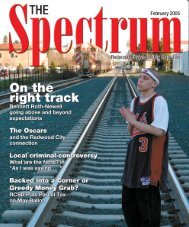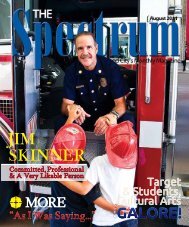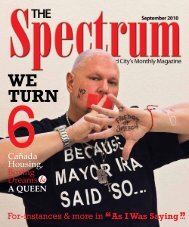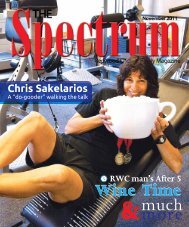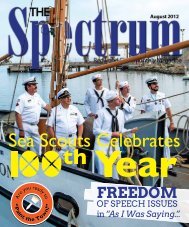F e e l i n g t h e n e e d - The Spectrum Magazine - Redwood City's ...
F e e l i n g t h e n e e d - The Spectrum Magazine - Redwood City's ...
F e e l i n g t h e n e e d - The Spectrum Magazine - Redwood City's ...
You also want an ePaper? Increase the reach of your titles
YUMPU automatically turns print PDFs into web optimized ePapers that Google loves.
IT’S ALL ABOUT THE KIDS: SLOWIN<br />
By Judy Buchan<br />
Contributing Writer<br />
McGarvey Avenue cascades from the heights of Farm Hill to the flatlands<br />
of Fairview, bringing with it the stuff of legend: speeding cars hurtling<br />
down the street, gaining enough velocity to go airborne, slamming into<br />
trees, parked cars and oncoming traffic.<br />
And rattling neighborhood nerves.<br />
Carol Grialou, a 35-year resident of McGarvey Avenue, says it’s not legend at all.<br />
She joins other longtime residents with tales of traffic nightmares on the oncequiet<br />
street. “When I moved in here in 1971, some of my neighbors told me the<br />
street had once been a dead end at the top of the hill,” Grialou said. With the<br />
advent of Farm Hill Boulevard and Interstate 280, Grialou believes her street has<br />
become a convenient shortcut to get from the hills to the flatlands. She would love<br />
to see traffic diverted from McGarvey at Farm Hill but knows that’s one sign that<br />
probably won’t be installed.<br />
As drivers gravitated to McGarvey over the years, so did problems associated with<br />
more traffic. “Oh, I’ve seen cars go airborne,” Grialou said. “I’ve had my cars and<br />
my trees hit,” she added.<br />
She called the city about traffic concerns shortly after she moved to McGarvey.<br />
After persistent phone calls, she recalled, “a man was sent out here at 2:30 in the<br />
afternoon to check the traffic.” When she asked him for his thoughts on how to<br />
handle the traffic situation, he replied, “Well, lady, I guess you haven’t had enough<br />
people die here yet.”<br />
While statistics indicate no one has died in a collision in the area, McGarvey resident<br />
Kathy Schrenk summed up the neighbors’ concerns quite succinctly: “Oh,<br />
there is a problem.”<br />
She sees a big part of the issue as “kids joyriding.” While she would like more<br />
police enforcement, Schrenk recognizes there are “other priorities.”<br />
Schrenk and her husband, Nathan, moved into their home in April 2002. In<br />
March 2003, the couple was awakened in the early hours of a Monday morning<br />
by a young woman at their door who was bleeding from a head wound. Schrenk<br />
said a car that appeared to have tried to jump another car had spun out on her<br />
front lawn, damaging her tree. <strong>The</strong> young driver was hospitalized overnight.<br />
Schrenk decided to bring the issue<br />
to the attention of the City<br />
Council, telling them that something<br />
had to be done. “Not a whole<br />
lot happened,” she said.<br />
A year later, a neighbor’s dog was<br />
killed by a speeding car. Schrenk<br />
again went to the City Council, and<br />
“not a heck of a lot happened.”<br />
With more neighbors calling the<br />
city on an individual basis to complain<br />
about traffic on McGarvey, all<br />
parties concerned decided it was<br />
time to get organized. When the<br />
neighbors formed the McGarvey<br />
Neighborhood Traffic Committee<br />
(www.mcgarvey-traffic.org), “the<br />
city started to be interested in<br />
working with us,” she recalled.<br />
That collaborative effort has<br />
included an initial workshop in<br />
January with all interested parties,<br />
including the president of Cañada<br />
College, who promised to get the<br />
word out about speeding to his students. Some 53 people were in attendance, with<br />
a wide range of issues on the table. Neighbors’ concerns focused a great deal on<br />
what they saw as a need for more enforcement. Some spoke of construction workers<br />
and delivery drivers speeding on McGarvey, others talked about “sideshow”<br />
activity and others considered McGarvey a “roller-coaster road.” Some neighbors<br />
wanted speed bumps going downhill on McGarvey, which cannot happen due to<br />
liability.<br />
Possible solutions to the issues of speeding and sideshow activity included educational<br />
efforts at Cañada College and Woodside High School. A suggestion to put<br />
“children at play” signs in the street was discounted by residents, who believed<br />
that 15 percent of the drivers exceeding the speed limit would not care. Other<br />
ideas were a barrier at Hetch Hetchy or Farm Hill, illuminated crosswalks and stop<br />
signs at major intersections, selective narrowing of McGarvey, and stop signs at<br />
every other intersection.<br />
Residents were also encouraged to call the City Traffic Hotline at (650) 780-7146<br />
to report areas where traffic enforcement is needed.<br />
A follow-up meeting was held in April, and the city suggested roadway modifications<br />
that will need neighborhood petition support for implementation. Among<br />
the ideas are a four-way stop at McGarvey and Euclid, an all-way stop at<br />
McGarvey and Connecticut, a traffic circle at McGarvey and east Chesterton for<br />
a six-month trial, chokers at McGarvey and west Chesterton for a six-month trial,<br />
chokers at McGarvey and Fernside for a six-month trial, and an all-way stop at<br />
McGarvey and Fernside.<br />
In addition, the neighbors received updated collision histories and speed surveys<br />
from the Police Department. A five-year history of automobile collisions on<br />
McGarvey Avenue supplied by the Police Department showed no fatalities. From<br />
September 2000 to September 2005, a total of 60 collisions were documented,<br />
with 10 shown as minor injury, 33 as non-injury, five as unknown injury, and 12<br />
as hit and run.<br />
And speed survey results for McGarvey Avenue from surveys taken in October<br />
2004, September 2005, November 2005 and January 2006 indicate none of the<br />
drivers reaching what is described by the Police Department as the “critical speed<br />
(85th percentile).”<br />
However, a survey of vehicles traveling over 35 miles per hour, broken down by<br />
hour, revealed there were speed limit violations. <strong>The</strong> Police Department used this<br />
survey for more targeted enforcement.<br />
20


